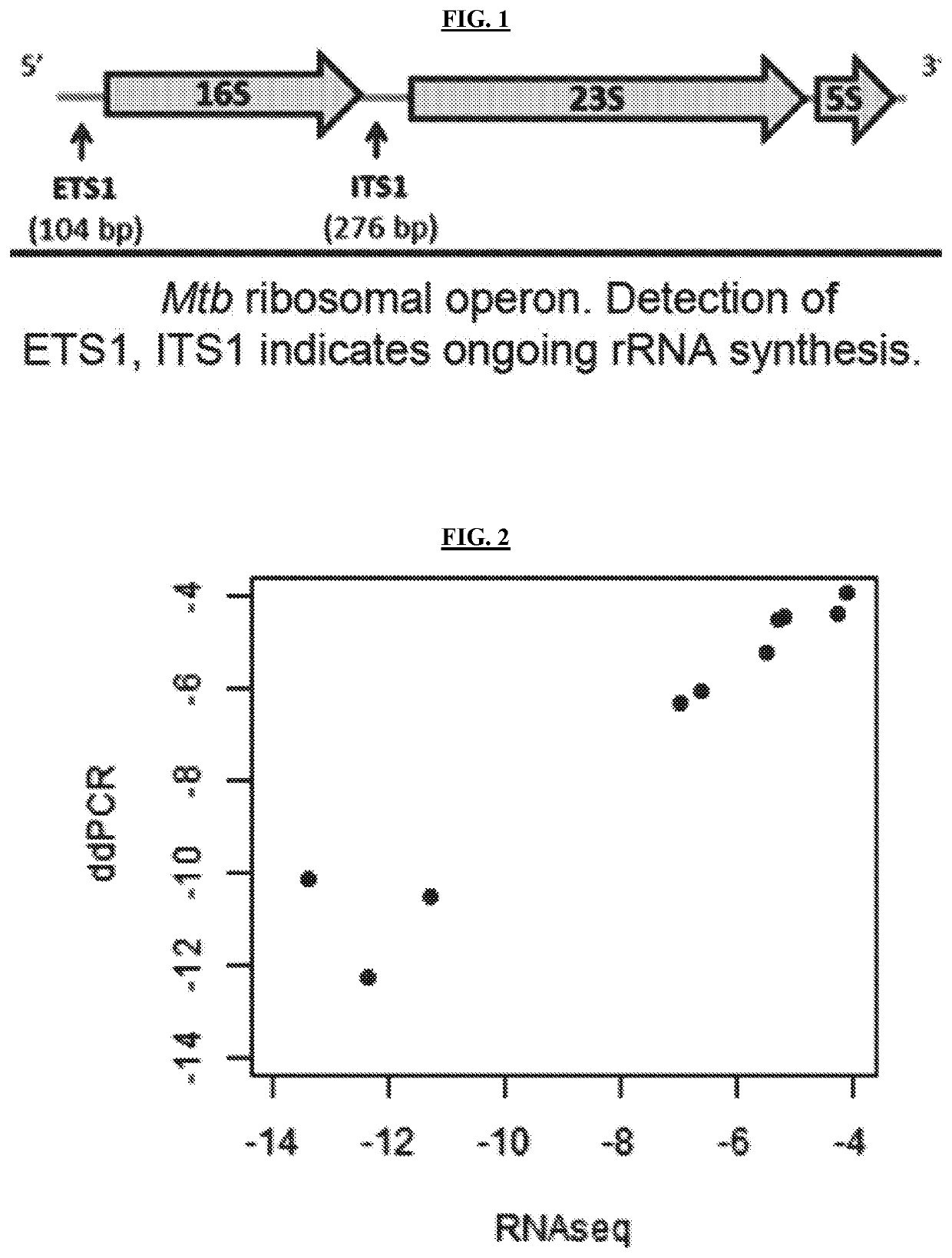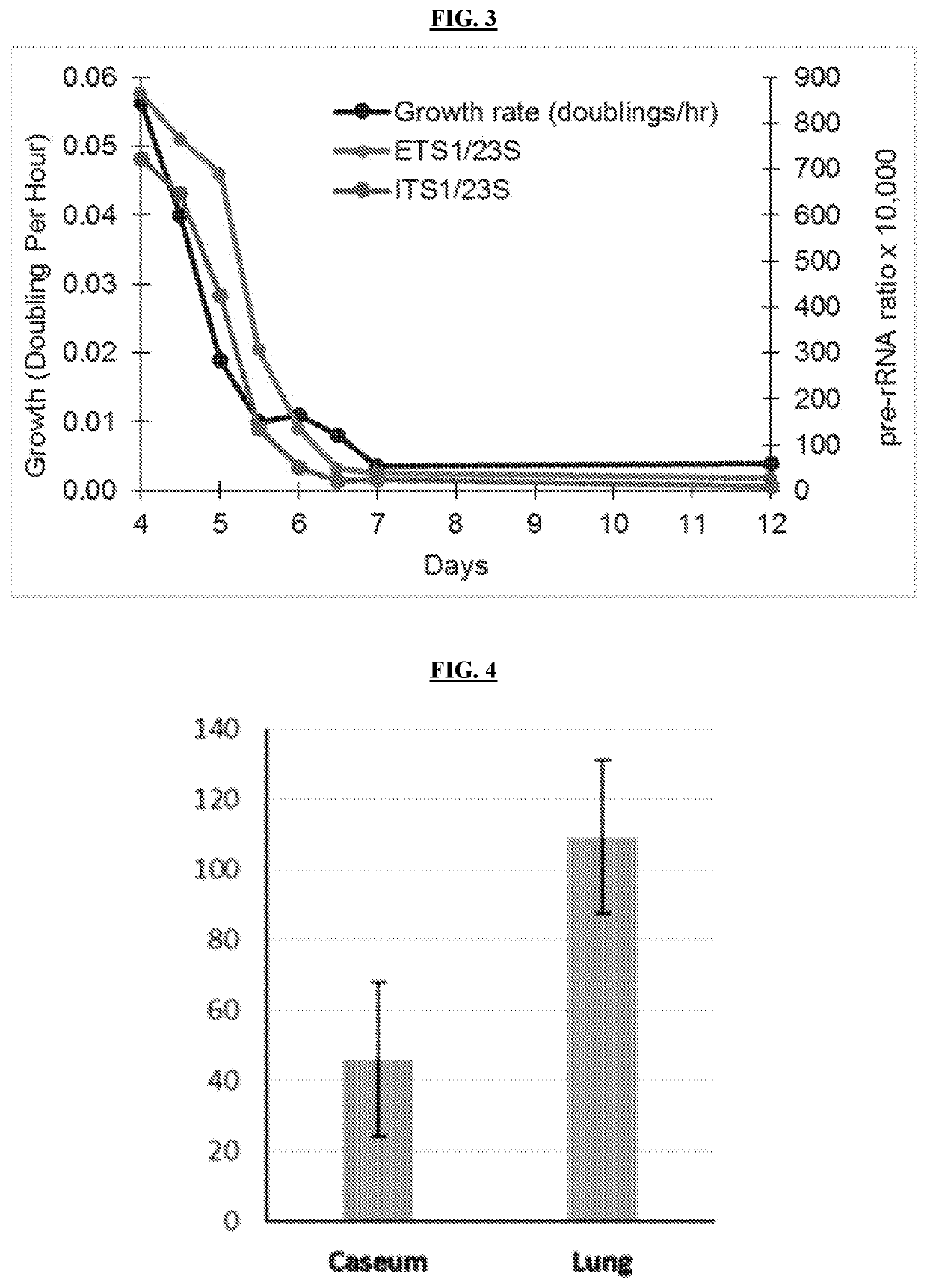Methods of Evaluating Treatment Efficacy and/or Treatment Duration in Mycobacterial Diseases
a treatment efficacy and mycobacterial disease technology, applied in the field of methods of evaluating treatment efficacy and/or treatment duration in mycobacterial diseases, can solve the problems of non-adherence to treatment, standard six-month, four-drug treatment regimen has not changed in nearly four decades, and mycobacteria is a leading cause of death worldwid
- Summary
- Abstract
- Description
- Claims
- Application Information
AI Technical Summary
Benefits of technology
Problems solved by technology
Method used
Image
Examples
example 1
Measurement of pre-rRNA
[0108]M. tuberculosis and M. abscessus re-rRNA and rRNA were assayed in three different labs using three platforms: RNAseq, qRT-PCR (TaqMan) and droplet digital PCR (ddPCR). A series of experiments were conducted to assure specificity of PCR primer / probe sets in order to avoid non-specific amplification. The PCR primer / probe sets for M. tuberculosis ETS1, ITS1 and 23S were validated by testing DNA from M. gordonae, M. avium, M. xenopi, M. szulgai, M. lentiflavum, M. neoaurum, M. mageritense, M. chelonae, M. cosmeticum, M. abscessus and human. The PCR primer / probe sets for M. abscessus ETS1, ITS1 and 23S were validated by testing DNA from M. chimaera, M. avium, M. intracellulare, M. chelonae, M. asiaticum, M. arupense, M. kansasii, M. kubicae, M. gordonae, M. malmoense, M. avium hominissuis, M. tuberculosis and human. No significant off-target detection was found. Primer / probe sets for M. abscessus were confirmed that amplify all M. abscessus subspecies by test...
example 2
Experimental Evidence that Pre-rRNA Ratios Elucidate Mycobacterial Replication Rate
[0111]A core microbiologic principle is that rRNA synthesis is directly correlated with bacterial replication. A series of experiments were conducted to validate that pre-rRNA ratios (a measure of rRNA synthesis rate) accurately measure mycobacterial replication rates. Because M. tuberculosis requires oxygen for growth, this was demonstrated in vitro in an oxygen depletion model. M. tuberculosis Erdman was grown in a capped tube with limited headspace. As oxygen was depleted, replication slowed from 0.056 doublings / hr (doubling time=17.9 hrs) to no growth. ETS1 / 23S and ITS ratios mirrored growth, decreasing 30-40-fold in the transition from aerobic to anaerobic conditions (FIG. 3). These results show that pre-rRNA ratios are an indirect measure of replication.
[0112]Additional experiments were conducted to determine whether pre-rRNA ratios correlate with mycobacterial growth rate in vivo (in the absenc...
example 3
Effect of Treatment-Shortening and Non-Treatment-Shortening Drugs on Pre-rRNA Ratios In Vitro
[0113]In one aspect, the present disclosure contemplates measuring drug effect on pre-rRNA ratios. A series of experiments tested impact of drug exposure on pre-rRNA ratios in vitro. These experiments exposed M. tuberculosis Erdman strain growing at log phase in culture to lethal doses of various antibiotics. After 99.9% of a bacterial population is killed, the surviving residual subpopulation withstands killing despite an absence of resistance-conferring mutations. In these experiments, 48 h of exposure to rifampin, isoniazid or streptomycin killed 99.99% of M. tuberculosis; 48 h exposure to bedaquiline killed ˜99.9%. RNA was extracted and pre-rRNA ratios were determined via ddPCR and RNAseq.
[0114]Drug impact on pre-rRNA ratios varied markedly between treatment-shortening (i.e., sterilizing) drugs such as rifampin and bedaquiline and non-treatment shortening (i.e., non-sterilizing) drugs su...
PUM
| Property | Measurement | Unit |
|---|---|---|
| Time | aaaaa | aaaaa |
| Time | aaaaa | aaaaa |
| Time | aaaaa | aaaaa |
Abstract
Description
Claims
Application Information
 Login to View More
Login to View More - R&D
- Intellectual Property
- Life Sciences
- Materials
- Tech Scout
- Unparalleled Data Quality
- Higher Quality Content
- 60% Fewer Hallucinations
Browse by: Latest US Patents, China's latest patents, Technical Efficacy Thesaurus, Application Domain, Technology Topic, Popular Technical Reports.
© 2025 PatSnap. All rights reserved.Legal|Privacy policy|Modern Slavery Act Transparency Statement|Sitemap|About US| Contact US: help@patsnap.com



